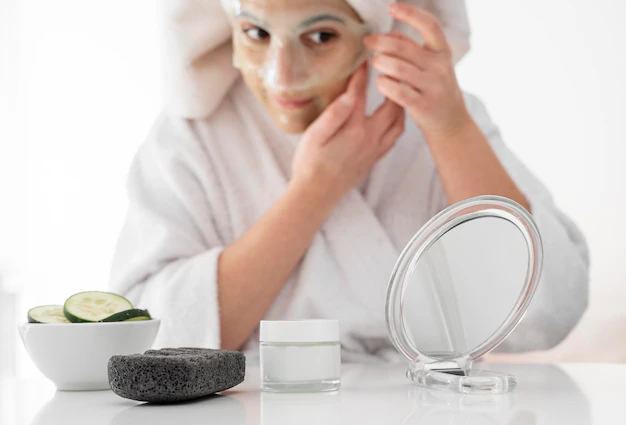Picking the ideal face moisturiser can feel like a challenging task. With countless options available, it’s reasonable to feel overwhelmed. The good news is that finding the right product is possible if you know what to look for. Understanding your skin type and knowing the benefits of different moisturising ingredients can help narrow down your choices. This guide covers everything you need to know, from identifying your skin’s unique needs to selecting the ideal moisturiser for a healthy, radiant complexion.
Understanding Your Skin Type
Before diving into the face moisturisers collection for different skin type, it’s essential to determine your skin type. The effectiveness of a moisturiser largely depends on how well it matches your skin’s needs. Here’s a quick breakdown of common skin types:
- Often characterised by a shiny appearance, especially in the T-zone (forehead, nose, and chin), oily skin tends to produce more sebum. People with this skin type are prone to acne and may experience enlarged pores.
- If your skin often feels tight or flaky, it’s likely dry. This type lacks sufficient moisture and can be prone to rough patches, especially in colder months.
- Combination skin has both oily and dry areas. Usually, the T-zone is oilier, while the cheeks are dry. This skin type can make finding the right moisturiser a bit tricky.
- Sensitive skin may react easily to products with symptoms like redness, itchiness, or stinging. It’s essential to choose products with gentle, hypoallergenic ingredients if you have this type.
- Those with normal skin have a balanced complexion with no excessive oiliness or dryness. A wide variety of moisturisers can work well for this type.
Key Ingredients for Different Skin Needs
Selecting a moisturiser isn’t just about choosing the one that claims to be the best. It’s also about understanding which ingredients suit your skin type and concerns. Some effective ingredients to consider based on specific skin needs are:
- Hyaluronic Acid is ideal for all skin types but is especially beneficial for dry skin. It attracts and holds moisture, keeping the skin plump and hydrated.
- Known for its acne-fighting properties, salicylic acid works well for oily or acne-prone skin. It penetrates pores, helping to keep them clear of excess oil and impurities.
- Ceramides strengthen the skin’s natural barrier, making them a great choice for dry or sensitive skin. They lock in moisture and protect against environmental irritants.
- Niacinamide reduces redness, soothes irritation, and regulates oil production. It’s suitable for sensitive, oily, and combination skin types.
- Ingredients like vitamin C and green tea extract protect the skin from environmental damage. These antioxidants are helpful for all skin types, adding an extra layer of defence against free radicals.
Finding the Right Texture
Beyond ingredients, the texture of a moisturiser plays an important role in its effectiveness. Below is a breakdown of different textures and how they align with various skin types:
- Lightweight and non-greasy, gel-based products are often water-based and provide quick hydration. They’re ideal for oily and combination skin.
- Lotions are slightly thicker than gels but still lightweight enough for oily and combination skin. They offer a balance of hydration without feeling too heavy.
- Thicker than gels and lotions, creams are best for dry or sensitive skin types. They provide a deeper level of hydration, creating a protective barrier that locks in moisture.
- Balms are rich and heavier in texture, making them suitable for very dry or mature skin. They provide intense hydration and are especially helpful in harsh weather conditions.
How to Incorporate Moisturiser into Your Routine
Adding a moisturiser to your skincare routine is simple, but consistency is key for best results. Here are some tips to maximise the benefits of your moisturiser:
- Always start with a clean face to ensure that the moisturiser can absorb fully.
- Moisturising on damp skin can help lock in extra hydration. Once you’ve cleansed, softly pat your face until it’s nearly dry, keeping a hint of moisture.
- Usually, a pea-sized amount of moisturiser covers the entire face effectively. Applying too much may clog pores, especially for oily skin types.
- If using serums, apply them before your moisturiser. This allows each product to work effectively without interference.
- For optimal results, moisturise both in the morning and at night to keep your skin consistently hydrated.
Exploring the Range of Face Moisturisers for Different Skin Types
With so many products available, exploring a face moisturiser can help you find options tailored to your unique needs. Many collections offer a variety of formulas designed specifically for dry, oily, sensitive, combination, or normal skin types. Whether you need a lightweight gel for hot summer days or a rich cream to combat winter dryness, choosing from a diverse collection ensures you’re getting a product formulated with your skin type in mind.
With the right face moisturisers collection for different skin type, finding the perfect match for your skin is easier than ever. From understanding skin types to choosing ingredients and textures, these considerations simplify the process. A well-chosen moisturiser tailored to individual skin needs not only improves skin health but also elevates daily skincare routines into a more fulfilling self-care practice.
Keep an eye for more news & updates on Gossips!




